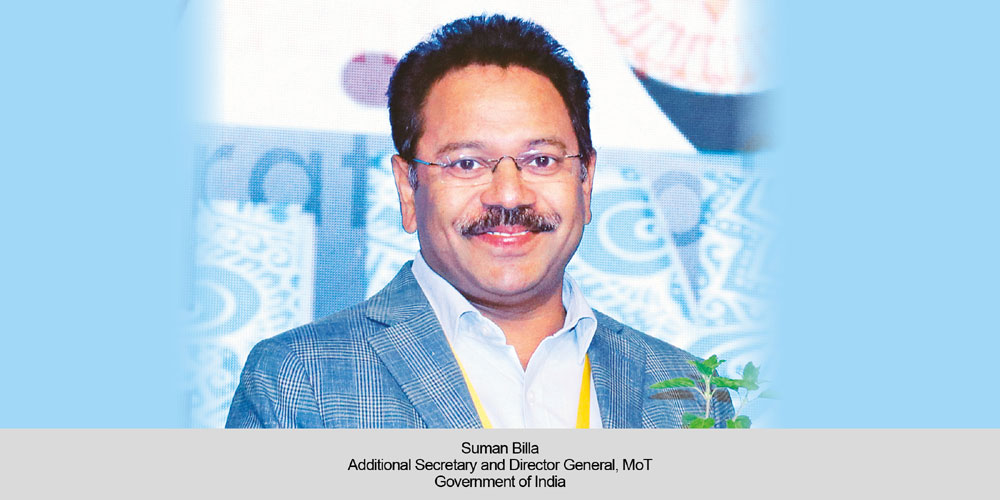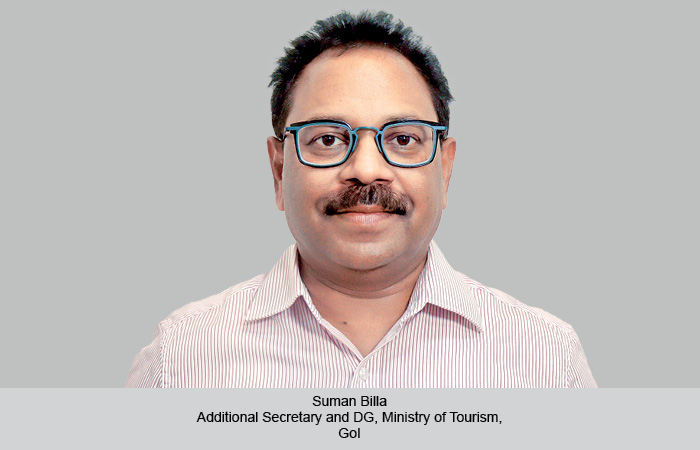Manisha Saxena, Director General, Tourism, Government of India, emphasizes on the need for a holistic approach to the country’s tourism growth, integrating domestic and overseas promotion, infrastructure development, sanitation, skill development, and collaboration with state governments.
Janice Alyosius
The tourism sector in India sees a surge in domestic and inbound tourism, nearing pre-pandemic levels. To further augment the growth, Manisha Saxena, Director General, Tourism, Government of India, stresses on the need for a holistic approach, linking domestic and overseas promotion efforts, investing in infrastructure, sanitation, skill development, and collaboration with state governments for sustainable tourism development.
Highlighting the current state of tourism sector in India, Saxena underlined the remarkable surge in domestic tourism and the recovery in inbound tourism to the pre-pandemic levels. “The tourism sector, particularly in India, is at an inflection point. We are witnessing a significant boom in domestic tourism and have seen a recovery to pre-pandemic levels in terms of inbound tourism. The ministry has been working on its promotion policy, it was undergoing transition a couple of years ago, and now we are leveraging the capabilities of Indian missions abroad,” she said.
She reassured stakeholders about the government’s commitment to tourism promotion, addressing concerns about budget allocation. “A lot of you have expressed concern about the decrease in the budget for overseas promotion, but I want to assure that it is merely a technical reduction. As you may have noticed, the amount has been increased for domestic tourism. It’s simply a matter of revamping the schemes and using them in tandem for both domestic and overseas promotion. After all, a tourist is a tourist; whether they come from abroad or are Indian tourists, they are invaluable to us. Therefore, the linkage between overseas and domestic promotions, especially in this age of digital media, has become increasingly vital. I believe it’s time for us to take steps to ensure that they work hand in hand,” she said.
Saxena shed light on the government’s initiatives, particularly under schemes like Swadesh Darshan, aimed at developing tourism infrastructure across various destinations in India. “Under the Swadesh Darshan scheme, numerous new destinations were created. A significant amount of tourism infrastructure was set up under the Swadesh Darshan 2.0 scheme. The scope of the scheme has been expanded, with a focus on infrastructure development to ensure the holistic development of entire destinations. During an exercise in the ministry, we realized that there are at least 22 touchpoints for a tourist, from the initial planning stages to posting feedback or memories on social media. This includes not only accommodations like hotels but also aspects such as learning about a destination, transportation to and from there, available activities, attractions, facilities, guides, basic amenities, local cuisine, street foods, intangible cultural experiences, and safety and security measures. We are now making efforts, in collaboration with state governments and district administrations, to address these points in each destination,” she said.
Saxena highlighted the meticulous considerations undertaken by the Ministry of Tourism when developing infrastructure and promoting destinations. One such crucial initiative discussed was the Swachhata Green Leaf Rating System (SGLR) ratings, aimed at ensuring the installation of safe sanitation facilities in hospitality units, especially in environmentally sensitive areas like hills and coastal regions. Saxena cited the successful pilot of this initiative conducted in Pahalgam in January, launched in December and completed within a month. She also announced plans for a similar initiative in the Neel Islands, underscoring the ministry’s commitment to expanding this program nationwide. “We are leveraging synergy with district Swachhata teams in this endeavour, aiming to ramp up Corporate Social Responsibility (CSR) with public sector undertakings (PSUs). We are also earmarking funds for it. I believe this will be a significant initiative over the next year, as we aim to develop at least 100 such destinations. This effort will showcase what can be achieved, even in the smallest hospitality units, in terms of technology adoption for safe sewage management and waste disposal” Saxena said.
Saxena emphasized the collaborative approach taken with state governments to identify areas for conversion into fully managed sanitation zones, whether they be beachfronts, blocks, or villages. The objective is to demonstrate the feasibility of such initiatives on a larger scale. The Director General of Tourism was addressing the 6th Hoteliers’ Conclave in New Delhi recently.
 TravTalk India Online Magazine
TravTalk India Online Magazine





